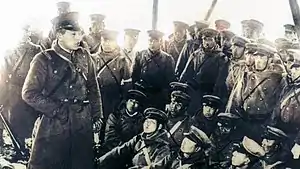February 26 incident
The February 26 Incident (二・二六事件, Ni Ni-Roku Jiken, also known as the 2-26 Incident) was an attempted coup d'état in the Empire of Japan on 26 February 1936. It was organized by a group of young Imperial Japanese Army (IJA) officers. They wanted the purging the government and military leadership because of bad economic policies.
| February 26 Incident | |||
|---|---|---|---|
 1st Lt. Yoshitada Niu and his company on February 26, 1936 | |||
| Date | 26–28 February 1936 | ||
| Location | |||
| Goals |
| ||
| Resulted in | Uprising suppressed
| ||
| Parties to the civil conflict | |||
| Lead figures | |||
| |||
| Number | |||
| |||
During this incident, the rebels assassinated two former prime ministers and occupied the government center of Tokyo. However, they failed in assassinating Prime Minister Keisuke Okada or take control of the Imperial Palace. With a lot of opposition against them, the rebels surrendered on 29 February.[3]
This was the last time that a former prime minister was assassinated until Shinzo Abe's assassination in 2022.
References
- Chaen (2001), p. 130
- Chaen (2001), p. 146. Number does not include IJN personnel.
- Jansen (2002), p. 598
This article is issued from Wikipedia. The text is licensed under Creative Commons - Attribution - Sharealike. Additional terms may apply for the media files.